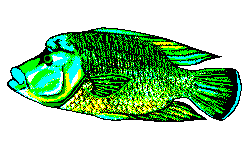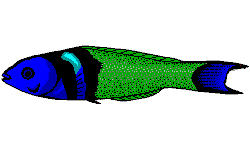| Species No |
Category |
Common_Name |
Species Name |
Length (cm) |
Length_In |
Notes |
Graphic |
|
90,050.00
|
Wrasse
|
Giant Maori Wrasse
|
Cheilinus undulatus
|
229.00
|
90.16
|
This is the largest of all the wrasse. It is found in dense reef areas, feeding on a wide variety of mollusks, fishes, sea urchins, crustaceans, and other invertebrates. In
spite of its immense size, divers find it a very wary fish.
Edibility is considered poor.
Range is the Indo-Pacific and the Red Sea.
|

|
|
90,250.00
|
Wrasse
|
Bluehead Wrasse
|
Thalassoma bifasciatum
|
15.00
|
5.91
|
Found in coral reefs, rocky flats, reef sand, and seagrass habitats. This is one of the most successful "cleaner fish" in the tropical West Atlantic. It feeds on the
parasites of other fish, who come to the wrasse to be cleaned.
Most bluehead wrasses are yellow. The head of the terminal-phase male (about 4% of the population) is blue.
Edibility is poor.
Range is large, including both sides of the Atlantic, Bermuda, Bahamas, and Florida to Curacao, plus the Gulf of Mexico.
|

|
|
90,300.00
|
Wrasse
|
Senorita
|
Oxyjulis californica
|
25.00
|
9.84
|
Found almost everywhere by divers, this fish lives either in schools or alone. It is a voracious eater that feeds constantly. It is also a very successful "cleaner fish", and a
single Senorita may be surrounded by dozens of fishes waiting to be cleaned of parasites. Divers report them teaming up to clean a large sea bass or Mola.
This fish does not reverse sex as most wrasses do. When disturbed, it burrows in the bottom sediment. It also sleeps there with its head protruding from the sand.
Edibility is poor.
Range is Northern California to Central Baja.
|

|


